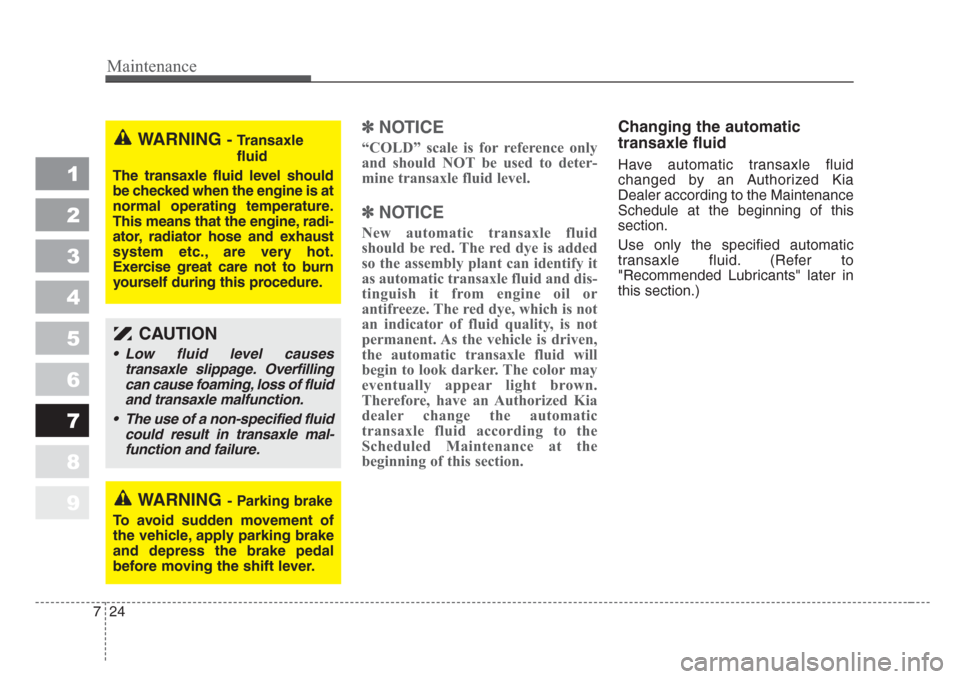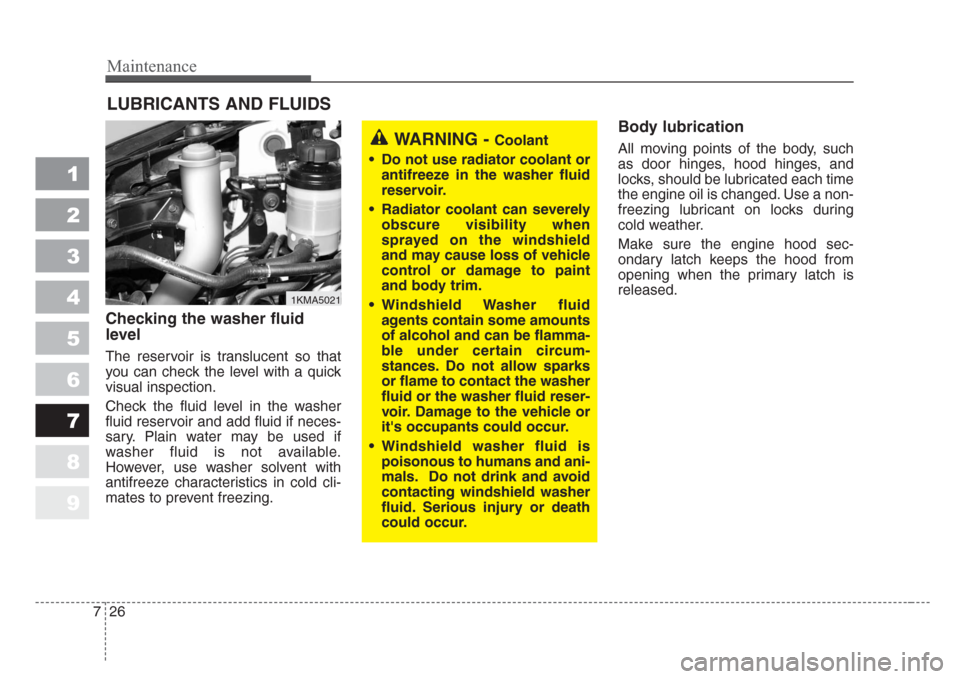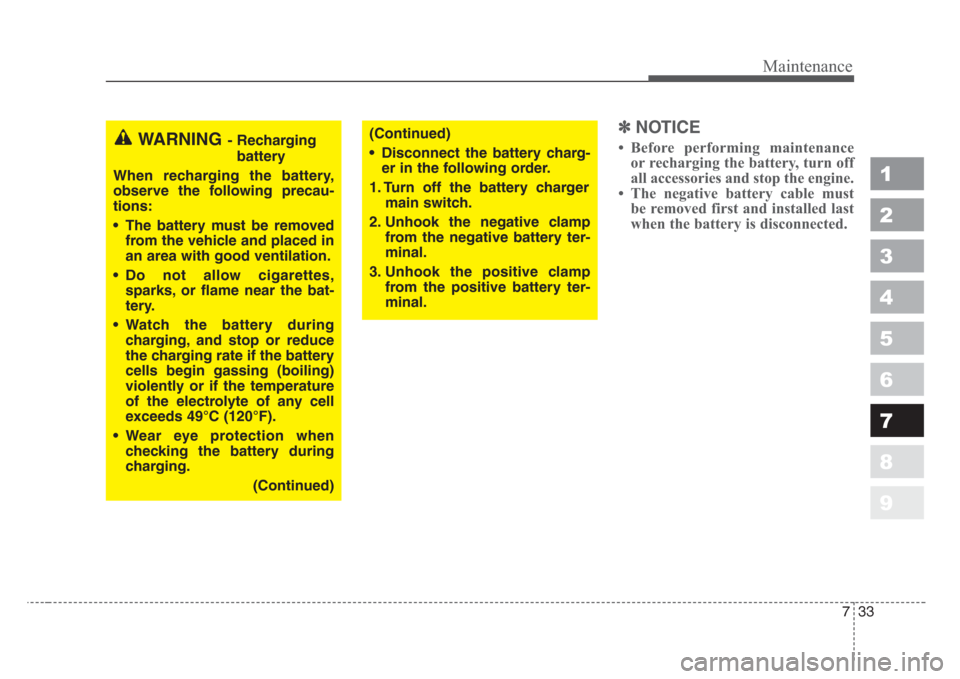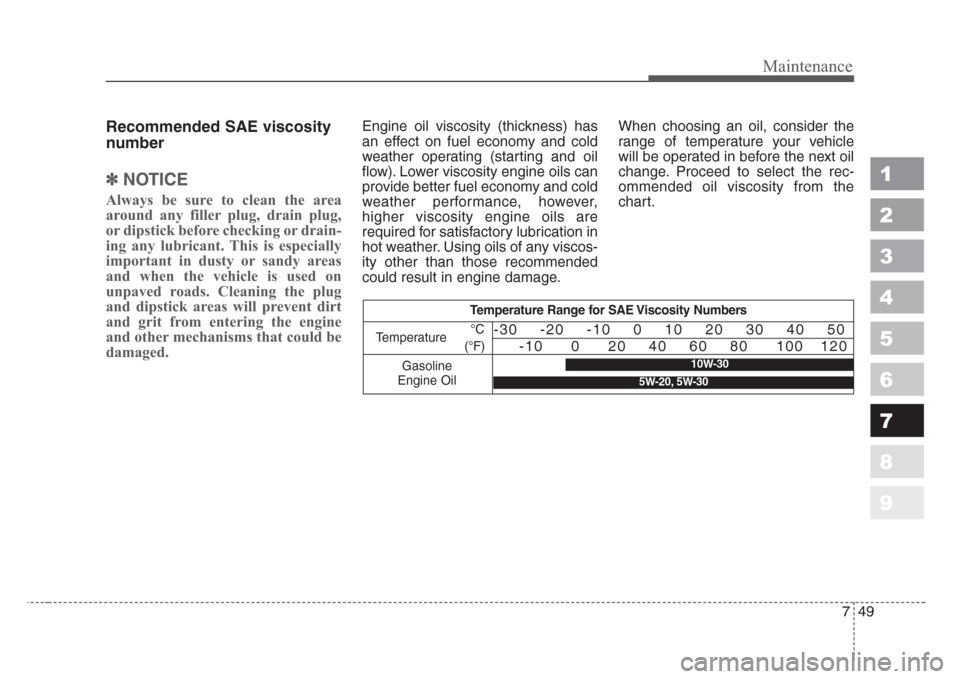Page 311 of 350

Maintenance
24 7
1
2
3
4
5
6
7
8
9
✽
NOTICE
“COLD” scale is for reference only
and should NOT be used to deter-
mine transaxle fluid level.
✽
NOTICE
New automatic transaxle fluid
should be red. The red dye is added
so the assembly plant can identify it
as automatic transaxle fluid and dis-
tinguish it from engine oil or
antifreeze. The red dye, which is not
an indicator of fluid quality, is not
permanent. As the vehicle is driven,
the automatic transaxle fluid will
begin to look darker. The color may
eventually appear light brown.
Therefore, have an Authorized Kia
dealer change the automatic
transaxle fluid according to the
Scheduled Maintenance at the
beginning of this section.
Changing the automatic
transaxle fluid
Have automatic transaxle fluid
changed by an Authorized Kia
Dealer according to the Maintenance
Schedule at the beginning of this
section.
Use only the specified automatic
transaxle fluid. (Refer to
"Recommended Lubricants" later in
this section.)
CAUTION
• Low fluid level causes
transaxle slippage.Overfilling
can cause foaming, loss of fluid
and transaxle malfunction.
• The use of a non-specified fluid
could result in transaxle mal-
function and failure.
WARNING- Parking brake
To a v oid sudden movement of
the vehicle, apply parking brake
and depress the brake pedal
before moving the shift lever.
WARNING -Transaxle
fluid
The transaxle fluid level should
be checked when the engine is at
normal operating temperature.
This means that the engine, radi-
ator, radiator hose and exhaust
system etc., are very hot.
Exercise great care not to burn
yourself during this procedure.
Page 313 of 350

Maintenance
26 7
1
2
3
4
5
6
7
8
9
LUBRICANTS AND FLUIDS
Checking the washer fluid
level
The reservoir is translucent so that
you can check the level with a quick
visual inspection.
Check the fluid level in the washer
fluid reservoir and add fluid if neces-
sary. Plain water may be used if
washer fluid is not available.
However, use washer solvent with
antifreeze characteristics in cold cli-
mates to prevent freezing.
Body lubrication
All moving points of the body, such
as door hinges, hood hinges, and
locks, should be lubricated each time
the engine oil is changed. Use a non-
freezing lubricant on locks during
cold weather.
Make sure the engine hood sec-
ondary latch keeps the hood from
opening when the primary latch is
released.
1KMA5021
WARNING - Coolant
• Do not use radiator coolant or
antifreeze in the washer fluid
reservoir.
• Radiator coolant can severely
obscure visibility when
sprayed on the windshield
and may cause loss of vehicle
control or damage to paint
and body trim.
•Windshield Washer fluid
agents contain some amounts
of alcohol and can be flamma-
ble under certain circum-
stances.Do not allow sparks
or flame to contact the washer
fluid or the washer fluid reser-
vo
ir.Damage to the vehicle or
it's occupants could occur.
•Windshield washer fluid is
poisonous to humans and ani-
mals.Do not drink and avoid
contacting windshield washer
fluid.Serious injury or death
could occur.
Page 314 of 350
727
Maintenance
1
2
3
4
5
6
7
8
9
AIR CLEANER
Element replacement
Have the air cleaner element
checked and replaced in accordance
with the maintenance schedule.
✽
NOTICE
Do not drive with the air cleaner
removed; this will result in excessive
engine wear.
1KMN5010
CAUTION - Engine
Driving without an air cleaner
encourages backfiring, which
could cause a fire in the engine
compartment.
Page 320 of 350

733
Maintenance
1
2
3
4
5
6
7
8
9
✽
NOTICE
• Before performing maintenance
or recharging the battery, turn off
all accessories and stop the engine.
• The negative battery cable must
be removed first and installed last
when the battery is disconnected.WARNING- Recharging
battery
When recharging the battery,
observe the following precau-
tions:
• The battery must be removed
from the vehicle and placed in
an area with good ventilation.
• Do not allow cigarettes,
sparks, or flame near the bat-
tery.
• Watch the battery during
charging, and stop or reduce
the charging rate if the battery
cells begin gassing (boiling)
violently or if the temperature
of the electrolyte of any cell
exceeds 49°C (120°F).
• Wear eye protection when
checking the battery during
charging.
(Continued)(Continued)
•Disconnect the battery charg-
er in the following order.
1.Turn off the battery charger
main switch.
2.Unhook the negative clamp
from the negative battery ter-
minal.
3.Unhook the positive clamp
from the positive battery ter-
minal.
Page 336 of 350

749
Maintenance
1
2
3
4
5
6
7
8
9
Recommended SAE viscosity
number
✽
NOTICE
Always be sure to clean the area
around any filler plug, drain plug,
or dipstick before checking or drain-
ing any lubricant. This is especially
important in dusty or sandy areas
and when the vehicle is used on
unpaved roads. Cleaning the plug
and dipstick areas will prevent dirt
and grit from entering the engine
and other mechanisms that could be
damaged.
Engine oil viscosity (thickness) has
an effect on fuel economy and cold
weather operating (starting and oil
flow). Lower viscosity engine oils can
provide better fuel economy and cold
weather performance, however,
higher viscosity engine oils are
required for satisfactory lubrication in
hot weather. Using oils of any viscos-
ity other than those recommended
could result in engine damage.When choosing an oil, consider the
range of temperature your vehicle
will be operated in before the next oil
change. Proceed to select the rec-
ommended oil viscosity from the
chart.
Temperature Range for SAE Viscosity Numbers
Temperature
Gasoline
Engine Oil°C
(°F)-30 -20 -10 0 10 20 30 40 50
-10 0 20 40 60 80 100 120
10W-30
5W-20, 5W-30